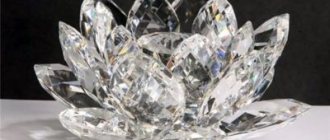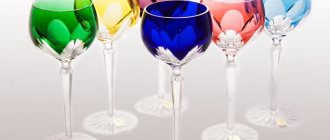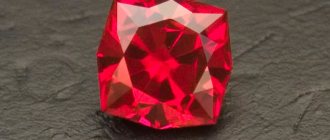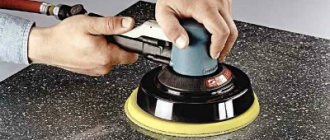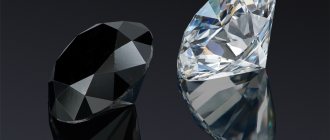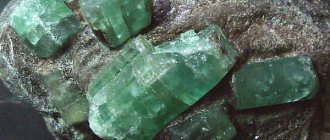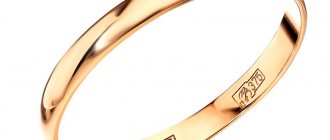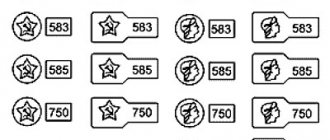Mineral glass and sapphire glass are two big separate worlds in watchmaking. Very often, buyers are disappointed in their next watch purchase because they do not understand the properties and purpose of this or that glass, and as a result, the accessory becomes another unnecessary purchase.
And so that you don’t run into the same rake, in this article we will explain to you in simple terms - how exactly they differ, and how you can avoid making mistakes when buying a watch.
Sapphire crystal is the most expensive glass that Swiss watch manufacturers like to use.
Its hardness is 9 out of 10 on the Mohs scale, second only to diamond. Therefore, it cannot be scratched with anything other than a diamond.
When purchasing a watch, you can often notice in the description information about the glass material. However, how can you determine whether a sapphire or mineral crystal is installed on a watch if you purchase the product second-hand or in unofficial stores?
Find out the country of the watch manufacturer by barcode:
Enter 13 digit barcode:
All types of watch glasses
Initially, personal watches, not yet wrist watches, but pocket watches, were equipped with rock crystal glass. The finest work, exclusively handmade, high cost and scanty editions... Of course, today this is a thing of the past. There are three main categories of watch glass:
- plastic;
- mineral;
- sapphire.
Plastic glasses are the most inexpensive and, at the same time, the most technologically advanced. This plastic has several names: acrylic glass, organic glass, hesalite glass, plexiglass...
The basis here is a thermoplastic resin - a vinyl polymer of methyl methacrylate. By the way, the common household word "plexiglass" comes from the brand name for such glass, Plexiglas, created in Germany in the 1930s.
Plexiglas turned out to be incredibly popular in aviation at that time, namely in the design of the cockpit canopy. Transparency, shatterproofness, ease of giving the desired shape: all these are the undoubted advantages of acrylic glass, which is still used everywhere today - even in ophthalmology and nanoelectronics. Of course, in the watch industry too! After all, plexiglass is light and impact-resistant, easily takes a given shape, is highly polishable, easy to manufacture and inexpensive.
Even 40–50 years ago, even brands such as Rolex used plastic glass in their watches. To this day, acrylic is very widely used in the budget segment and in sports watches.
Thus, Casio installs plastic glass in all models of its extensive Collection line; domestic Vostok watches, American Timex, Italian Diesel, and Swiss Swatch are equipped with the same glass.
However, the disadvantages of plastic glasses are also quite significant. The main thing is that plexiglass is easy to scratch and rub, as a result of which it becomes cloudy. The durability of acrylic is not great; you will have to change the glass often (or even the watch as a whole - if it is more expensive, it is not much). Other types of glass are coming to the forefront - mineral and sapphire.
Different kinds
There are three main types used in modern conditions: plexiglass or, as it is also called, plastic, as well as mineral and sapphire glass, although the first, in fact, is not it. In reality, of course, there are many more types, since various coatings, additives, etc. are used. Without some training, not everyone will be able to distinguish one type from another, but for a specialist or just a person who has some experience working with glass, this will not be a lot of work.
Sapphire glass: what is it and how is it made?
Sapphire crystal is glass made from sapphire fiber rather than the mineral itself. But despite this nuance, the artificial material is in no way inferior to natural sapphire.
Preparation method
Sapphire crystal is the highest level of this wristwatch component. The method is quite interesting and almost magical.
It is related to the sapphire gemstone in that it is also crystalline aluminum oxide (Al2O3), one of the varieties of corundum. And it is distinguished by its artificial origin - first synthesized by the French chemist Auguste Verneuil in 1904 - and complete transparency.
Aluminum oxide is heated to 200 degrees Celsius. After this, a sapphire crystal is added to it. High temperature causes the atoms of these two elements to begin to interact with each other, thanks to this process the artificial sapphire hardens.
In structure, it is a single crystal obtained as a result of the melting of aluminum oxide in the flame of a hydrogen-oxygen burner and the subsequent deposition of droplets, which, when cooled, form a crystal. Synthetic sapphires are cut into thin (of the required thickness) sheets - this is the finished sapphire glass, or rather, blanks, from which glass is then made for watches and other devices.
This material is then cooled and processed and polished. Sapphire is very hard, second only to diamond (9 on the Mohs scale versus 10), which is why it is cut with a diamond tool. As a result of this process, sapphire glass is formed, which has high strength and wear resistance.
Of course, this process of manufacturing sapphire glass is quite expensive and complex, which determines the high cost of watches with this type of glass.
Basic properties of sapphire glass
Officially, this substance is called monocrystalline aluminum. Not nearly as beautiful, right? And in fact, it is not glass at all, but crystal. He has a very mediocre attitude towards sapphires, because we are not talking about natural stones, but those obtained in laboratory conditions. However, this does not detract from the excellent properties of this material.
Firstly, it is extremely wear-resistant. It is quite difficult to scratch it with anything other than diamond, so it is not afraid of any abrasions or clouding. On the one hand, this prolongs the life of the products, but on the other hand, it complicates processing, and therefore increases the cost of production. Secondly, this material has a beautiful glossy shine and significant transparency. And thirdly, it is very fragile. Surprisingly, like diamonds, having enormous hardness, sapphire glass breaks easily, so products made with it should be treated with care.
Mineral glass: what is it and how is it made?
Mineral glass, as you might have guessed, is made from the mineral quartz (quartz sand).
But there are also combined types of mineral glass, which have their own unique characteristics:
- Sapflex - mineral glass with sapphire coating. Such glass is better protected from scratches, its surface is smoother and has water-repellent properties.
- Hardlex is a mineral glass that is tempered in a special way using Japanese Seiko technology. Due to this “hardening”, the glass becomes stronger and has shockproof properties.
- Crystex is another type of mineral glass made by combining quartz sand and frit, a glass-like material. Thanks to this composition, the glass is highly durable and increases the wear resistance of the watch.
How is mineral glass made?
Quartz sand is heated and metal oxide is added to it. After this, the resulting substance is given the required shape, gradually cooling. This is how mineral glass is obtained.
Plastic
Another popular type of glass used in Casio watches (for example, in models W-800HG-9AVEF, AW-80-1AVEF, A168WA-1YES) is plastic.
In another way it is called acrylic, or organic. Made from very inexpensive silicate glass. The technology for its production is also cheap (and also simple), which is why this material is characterized by such a low cost.
However, this glass is stronger than sapphire and mineral glass, so it is often installed in mid-priced Casio watches (for example, SGW-450HD-1BER, AQ-S800WD-1EVEF, SGW-300H-1AVER).
At the same time, this material is very plastic and soft, which is why it quickly collects scratches. After some time it may become dull or cloudy. Therefore, it is often installed in watches that are intended for sports - functionality is more important in them than appearance (for example, AE-1000W-1AVEF, STR-300C-1, AE-1300WH-1A2VEF).
Which glass is better?
When comparing these two types of glass, it is impossible to definitively answer which is better and which is worse. Each of them has its own advantages and disadvantages, which we will discuss in the next paragraph.
Of course, sapphire glass is more durable and scratch resistant than mineral glass. However, models with sapphire crystal are noticeably more expensive.
If durability and prestige are important to you, and you can’t stand the price, then without a doubt choose sapphire crystal. Take a closer look, find out everything about anti-reflective coatings, and find out what kind of glass is installed on the back of the case to view the mechanism. Sometimes they put sapphire on the front and mineral on the back. This is acceptable, although a solid sapphire will warm your heart more.
As for external characteristics, they are no different. Mineral and sapphire glass have almost the same transparency and purity, however, when the sun appears, mineral glass will produce glare.
If your money still likes to count, but durability, at least moderate, and an elegant appearance also matter, then your option is mineral glass. Don't forget that there are mineral glasses with sapphire coating, as well as glasses that are strengthened through a special (patented and often secret) treatment.
If your priority is fast-changing fashion, then you should take a closer look at plastic: it is used in many fashion models produced literally for every new season. There is no question of durability, it is inexpensive... however, you should take into account that buying a watch 4 times every year can add up to a significant amount. By the way, acrylic is often used on sports wrist gadgets.
Therefore, when choosing between sapphire and mineral glass, pay attention to the purposes for which you need this watch: if you lead an active lifestyle, then choose, of course, sapphire glass, as it has impact-resistant properties and withstands any scratches, in all In other cases, mineral glass is in no way inferior to sapphire glass.
Pros and cons of sapphire and mineral glass
So, all the parameters of the two types of glass are clearly presented in the table:
| Characteristic | Sapphire | Mineral |
| Hardness | Scores 9 out of 10 on the Mohs scale, meaning scratches only occur when interacting with diamond | Scores 6.5 out of 10 on the Mohs scale, meaning scratches occur upon contact with hard metal objects |
| Strength | Impact resistant, but less durable than mineral glass. But manufacturers make this glass thicker, which reduces its fragility | Withstands serious impacts, cracks only with intense point impact |
| Wear resistance | Virtually invulnerable to damage | Scratches appear if handled carelessly |
| Transparency | Clear images throughout the entire life of the watch, resistant to glare in the sun. Restoring transparency is practically not required. | Scratches create cloudiness, which affects the transparency of the glass. This glass also produces glare in sunlight. Severe clouding requires polishing. |
| Price | Starts from 5,000 rubles | Chinese analogues cost 200-500 rubles, the original costs from 700 rubles. |
Application
First and foremost, of course, plexiglass, mineral or sapphire glass is used in the watch industry to protect the dial. But in the near future there is talk that they will also be used to cover the screens of smartphones, laptops and other electronic devices. The mineral variety has been used for quite a long time, but sapphire glass for watches and touch devices was developed relatively recently. Of course, there are already patent wars going on about this, and competitors are arguing about which type is better. So, what is the difference between the two most common materials, and which one should you prefer?
Price
Budget watch models are never equipped with sapphire crystals; if you are convinced otherwise, it is a fake.
If you apply a drop of water to mineral glass, it will flow off, leaving behind a “wet” trace. On sapphire glass, a droplet will roll like a mercury ball. Moreover, if the glass has an anti-reflective coating, a drop of water will not even budge.
How to tell the difference?
First of all, this can be done by marking sapphire glass or crystal glass. The latter refers to mineral. If there are no markings or it is necessary to check, then you will have to find out through a series of experiments.
The simplest one is to determine how quickly the glass heats up. Sapphire remains cold much longer than the mineral variety, but in this case it is necessary to have something to compare with.
Another way is to try to scratch the glass with something metallic. Sapphire will not give in, but mineral may leave a scratch. In addition, recently so many new technologies have appeared for the manufacture of organic glasses that their hardness has increased significantly, so even this test may not help. Another type of check is also not very accurate, but can be useful. You need to drop a little water on the glass and tilt the surface. Liquid will easily slide off organic glass, but on sapphire glass, especially with an anti-reflective coating, it will seem to stick, retaining its shape.
In any case, the marking of the latest variety must be present. You also need to remember that sapphire glass simply cannot be cheap. So a price that is too low is a reason to doubt the seller’s honesty and demand documents for the goods.
Is it possible to scratch
Sapphire glass is not susceptible to scratches, but it is quite easy to break. Watches with mineral glass may leave scratches.
From the above, the first advantage of sapphire watch crystals is clear - they are almost impossible to scratch. Hence the disadvantage: fragility, which is the sister of hardness... But if you handle the watch carefully - and sapphire crystals are used on luxury watches - then the glass will retain its appearance almost forever!
Because to apply scratches you need to make special efforts: use a diamond in one or another of its incarnations - in a piece of jewelry or, more simply, in a cutting tool with diamond chips. But why? The main thing is not to break it.
Another important advantage of sapphire glass is its complete transparency.
We just talked about the beautiful appearance, but this is conditional, because sapphire glass is so transparent that sometimes it seems as if it is not there at all! However, there is also a drawback: it glares a little worse than mineral. Therefore, a special anti-reflective coating is applied to the glass on at least one side (and often on both).
The method was invented in 1935 by Alexander Smakula, who worked for the great company Carl Zeiss: a special composition (for example, a compound of aluminum oxide with magnesium fluoride and hafnium dioxide) is condensed onto the surface to be treated in a vacuum chamber. The result is a thin film (tenths of a micron), which reduces light reflection and increases image contrast.
Initially, anti-reflective coatings were used for lenses of photo and movie cameras, as well as for binoculars, optical sights, etc. They began to be used in watches with the advent of sapphire crystals. Sometimes they are applied to mineral glass, also to eliminate glare.
It is not difficult to determine whether there is an anti-reflective coating on the glass: this is done purely visually, you just need to find a suitable angle. Treated glass will give a bluish tint (less often, a reddish tint).
It should also be said that the coating itself, unlike sapphire crystal as such, is very easy to scratch. Accordingly, if it is applied only on the inside, then nothing, but if on the outside, then over time it will have to be applied again. The procedure is not cheap, but we are also talking about elite, very expensive watches.
What functions do glass on watches perform?
The main purpose of the glass is, of course, to protect the dial and hands from external damage , as well as from the ingress of water and small particles, such as dust and dirt. Therefore, its choice should be treated with special care in order to maintain the durability and good appearance of the watch.
Graphic representation of glass functions on a wristwatch
Previously, all watch glasses were made exclusively from quartz or rock crystal (another name for quartz), but now the industry has stepped far forward and offers various analogues, such as polycarbonate, sapphire fiber, plexiglass and others.
It is these glass materials that we will talk about next. Let's start with, perhaps, the most common ones - sapphire and mineral.
Hardness measurements
Of course, the most accurate method is to measure the hardness of glass on the Vickers scale using special equipment. Mineral glass will show a hardness range from 500 to 800, and sapphire - from 2,200 to 2,300. However, this method is only suitable when you already have the watch and you have the opportunity to submit it for such an examination.
Mineral or sapphire: comparative characteristics
They differ significantly in price, properties and prevalence. Both varieties have their advantages and disadvantages. And yet, sapphire crystal on watches has become more of a status symbol than a necessity, while mineral glass seems to be the preserve of the middle class. Is it really?
Sapphire glass is harder. Usually, according to the Mohs school, it is assigned a value of 9, while mineral is content with a value of 6.5. This means that any metal keys can damage it. On the other hand, sapphire coating can prevent this problem.
Mineral glass is less fragile. Unfortunately, the sapphire crystal is very easy to break, so it is not worth hitting the watch dial with a hammer. Recent developments and improvements in mineral glass have shown that it is 2.5 times more difficult to destroy.
Sapphire crystal is thicker and heavier. For watches this is not of serious importance, but for the screens of electronic devices it is quite important. The thinner the glass, the better the touch screen responds to touch. The mass of mineral glass is 1.6 times less than its analogue. The difference is small, but due to the desire for compactness this can be an advantage.
Finally, the price. Sapphire glass is difficult to process, so its production cost is approximately 10 times higher than in the case of mineral glass. It takes more energy to make it, and the process is also quite environmentally unfriendly.
The sapphire revolution that never happened
Almost everyone knows the not-so-pleasant feeling somewhere in their chest when their smartphone suddenly slips out of their hands and falls to the floor, remaining face down - after all, the seconds while the device is still upside down may be the last time the owner has not yet seen the touchscreen is broken or cracked. If, of course, you are lucky, you can get away with light scratches, which, however, in itself is also unpleasant.
Tempered Gorilla Glass, produced by the American company Corning, over the past seven years has become the de facto standard and most durable material for use as a covering material for touchscreens in the fastest growing segment of mass electronic devices - smartphones. Comparing the consumer properties of Gorilla Glass and the plastic covers of touchscreens of handheld devices, which were popular before the iPhone appeared on the market, is even somehow funny. However, while it is an absolute advantage over its predecessors, Gorilla Glass is not perfect: it can be scratched by keys in your pocket or broken by dropping a smartphone on the floor, and the owner of the device at this moment will not care what kind of covers the displays of older devices had. Therefore, the topic of creating new coating materials for mobile device displays that are more scratch-resistant and less fragile remains relevant.
Corning
The Corning company, founded in the mid-19th century, from the very beginning specialized in the production of glass, ceramics and other similar materials.
In 1952, a malfunction of one of the furnaces in the Corning laboratory accidentally produced a milky-white synthetic glass-ceramic material, later called Pyroceram, which was lighter than aluminum, harder than high-carbon steel and subsequently became widespread. The discovery of Pyroceram was not only the reason Corning released the popular CorningWare line of cookware, but also the creation of the Project Muscle initiative, in which company scientists began research into increasing the strength of glass.
In 1962, the company introduced durable Chemcor glass to the market, hoping that it could be used in eyeglasses, vending equipment, cars, etc. However, Corning was unable to convince mass product manufacturers of the need for the new material, and in 1971 production of Chemcor was discontinued.
The company remembered it again only in 2005, when the famous Motorola V3 RAZR phone appeared on the market, which used a glass display cover instead of a plastic one. Upon learning of this, Corning formed a small team whose goal was to study the possibility of modifying Chemcor for use in various personal devices, such as phones or watches. The old Chemcor samples were 4mm thick, so there was a lot to work with. The project was called Gorilla Glass, but by the beginning of 2007 the research team could not boast of significant progress towards the goal. The iPhone prototype presented on January 9, 2007 was equipped with a plastic display cover, but Apple soon decided that using scratchy plastic in the new device was not the most suitable option. Steve Jobs approached Corning with a proposal to develop and produce large quantities of new glass in six months, which would be thinner - 1.3 mm - and stronger than existing available materials. The task seemed fantastic, and the head of Corning, Wendell Weeks, initially refused Jobs, but the latter showed persistence, convincing him to start work. By the end of March, the company’s specialists had decided on the final formula of the new material, but they needed to solve another, no less important problem: to set up production with a high yield. There was no time to build new lines, so the company's engineers decided to modify the existing facilities, and they managed to complete this difficult task: by July, they had produced so much new glass that they could cover several football fields. The smartphone boom, initiated by the appearance of the iPhone, allowed Corning to produce glass for 20% of all mobile phones produced in the world in 2010. Since 2012, every year the company has released new types of Gorilla Glass (2, 3, 4), each of which had significantly better characteristics than its predecessor.
Sapphire is coming...
Despite the dominance of Gorilla Glass, two or three years ago observers and experts began talking about the imminent emergence of a serious rival to tempered glass - synthetic sapphire. This material has long been used in expensive watches, and its first widespread use in smartphones dates back to 2013, when Apple equipped the iPhone 5 with a sapphire cover for the rear camera lens.
Sapphire is a gemstone (a type of corundum, chemical formula - aluminum oxide, Al2O3) that occurs in nature in various colors depending on impurities. The most common sapphire is blue (the name comes from the Greek σάπφειρος - blue stone), due to impurities of titanium and iron. Nature made sure that among the color variety of sapphires there was also a colorless, transparent form suitable for use as a cover for touchscreens of smartphones. Sapphire is one of the hardest materials - 9 out of 10 on the Mohs scale, second only to diamond, which scores a full 10 out of 10, and significantly superior to glass, which scores a relatively modest 5 out of 10. So, not like car keys. , lying in the same pocket with a smartphone, not a grain of sand that gets on the display while wiping the display will be able to scratch the sapphire cover.
The mass electronics industry requires significant quantities of material to cover displays, so in the case of sapphire, one cannot rely on the extraction of natural minerals on an industrial scale. Instead, it is much more effective to use the process of growing synthetic sapphire crystals from aluminum compounds with oxygen in electric furnaces at temperatures of about 2000 °C. This method, invented at the beginning of the last century, was named after its creator, the French scientist Verneuil. The single crystals obtained in this way are called “boules”; they are completely colorless and transparent if no impurities have entered them during their growth.
In November 2013, it became known that Apple had invested $578 million in a new plant of the American company GT Advanced Technologies in Arizona, which would produce synthetic sapphires. By that time, Apple was already using sapphire crystals in the cameras of the iPhone 5 and iPhone 5S, as well as in the Touch ID fingerprint sensor in the iPhone 5S, but such a significant investment (the Arizona plant had to be able to produce more sapphire crystals than all other facilities in the world together) could not but give rise to speculation that the company was going to use sapphire covers more widely, namely in the iPhone 6. In March of the following year, it became known about Apple patents that described the use of a laser for cutting boules into finished parts and some other technologies, improving the process of manufacturing sapphire components.
...and retreats
It seemed that the partnership between Apple and Corning was doomed. Corning shares fell, and potential owners of new smartphones discussed the advantages of sapphire displays. But what happened happened: the iPhone 6 and 6 Plus, introduced last fall, still had glass-covered displays, GT Advanced Technology's shares, which had previously been growing by leaps and bounds, collapsed, the company began bankruptcy proceedings, and numerous observers began to tell why Gorilla Glass is currently a more suitable coating material for smartphone displays than sapphire crystals.
A couple of weeks before the presentation of the iPhone 6, reports appeared on the Internet that the device would not use sapphire crystals, since the new enterprise could not produce the required amount of material. However, the release of components for new iPhone models begins several months before their introduction, which means that insiders should have known about the absence of sapphire crystals in the new product long before the announcement, and the rumors that appeared on the Internet were just rumors. Ducks, in a word. Apple had other, more compelling reasons to stick with Gorilla Glass.
One of the main directions in the development of mobile devices is to reduce their weight while simultaneously increasing the size of the display. The touchscreen cover is one of the heaviest parts of a smartphone. Sapphire crystal has a 67% higher density than glass, which means that in smartphones with a display size of about five inches, the mass of the sapphire display cover can reach 100 g. Corning has learned to produce glass covers as thin as a sheet of paper, and sapphire crystals need to be a third is thinner to have the same mass. Cutting such a thin layer of sapphire from a boule and then polishing it is not an easy task at all, and even more difficult in mass production. Additionally, sapphire cannot be molded like glass, so the iPhone 6's curved display design apparently did not include a sapphire crystal in the first place.
Another important requirement for every component of a mobile device is its ability to save battery power, and in this discipline, sapphire crystals again lose out to durable glass. One of the most significant consumers of electricity in a smartphone is the display backlight. Sapphire transmits light much less well than glass, which means that when using its crystals as a display cover, the backlight intensity must be significantly increased to achieve the same level of brightness as in the case of glass. In addition, there will be much more glare on the sapphire cover, and the application of an anti-reflective coating eliminates the main advantage of the material - scratch resistance.
An important disadvantage of sapphire cover is its high cost. The price of a device is an important factor in its popularity, especially with the high level of competition seen in the smartphone market. Producing a display cover from a sapphire crystal is an order of magnitude more expensive than in the case of glass - a few dollars versus several tens of cents per square inch, and in practice this means that the use of sapphire will increase the cost of the finished device by at least $100. Indirect confirmation This can be done by the Garmin Fenix 3 GPS wristwatch, which in the Sapphire version costs the same $100 more than in the version with glass. Of course, in the case of large production volumes, the cost of crystals will decrease somewhat, but the tens of times higher energy costs of production compared to glass will not allow the price of the material to be reduced to a level comparable to glass, and they also make the production itself unenvironmentally friendly.
In addition, smartphones have a relatively short life cycle, and regular additional costs when upgrading a device are unlikely to please consumers. If a wristwatch with sapphire crystals can be used for many years, then in the case of a smartphone, after a couple of years the buyer receives the same outdated device, but only with an intact display cover, having paid an extra hundred dollars for it. Most likely, the mass buyer will prefer to save these hundred dollars and will be content with minor scratches on Gorilla Glass.
All of these problems can be solved in a more or less effective way, but there is another significant drawback of sapphire caused by its nature. This is... insufficient strength. While sapphire is generally noted to have excellent scratch resistance, its crystalline structure makes it brittle. If you drop a smartphone with a sapphire display cover, it is more likely to break than in the case of glass, which is more elastic and therefore much better able to withstand deformation. In the case of wristwatches, this is not so important, since the watch is much more difficult to drop, and its cover is significantly smaller than that of smartphones. A broken touchscreen is a much bigger nuisance than scratches.
Thus, while virtually the only advantage is high scratch resistance, sapphire crystals have several significant disadvantages that, at least for the time being, make them of little use as a replacement for durable glass for display covers.
For GT Advanced Technology, Apple's decision to abandon the use of sapphires in the displays of iOS devices was fatal - it actually led to the bankruptcy of the company. Litigation between the partners eventually led to an amicable settlement, according to which GT Advanced Technology retained ownership of the equipment purchased with funds borrowed from Apple in order to be able to sell it and pay off the debt. Apple retained the never-operational factory and the option to acquire GT Advanced Technology's intellectual property. And if initially observers suggested that thanks to this Apple would be able to independently produce sapphire components, then in February it became known that the company intends to use the space of the former plant to deploy a new data center, investing $2 billion in it.
Phire vs Sapphire
Despite the fact that Corning introduced Gorilla Glass 4 only in November last year, already in February of this year it talked about a new project called Phire, the goal of which is to create a material that combines the positive properties of both Gorilla Glass and sapphire crystals.
According to Corning, tests have shown that Phire is significantly stronger than Gorilla Glass 4. However, each new generation of Corning glass can boast of this over its predecessors. In the case of Phire, what is unusual is the significantly increased scratch resistance of the material. The picture shows a slide from the presentation of Phire, which demonstrates that as a result of applying the same force to scratch the surface of the material, significant defects appeared on Gorilla Glass, while Phire remained almost unchanged, like the sapphire crystal.
Currently, the threat of competition for Corning products from sapphires has significantly decreased, therefore, by releasing such a product, the company can make it somewhat more expensive than previous offerings. Device makers will be able to get the new material as early as the second half of the year, so it's possible more information about Phire will be revealed soon.
Is revenge possible?
Despite the unsuccessful assault on Apple products, sapphire crystals have found their place in some smartphone models - for example, the protected Kyocera Brigadier and the fashionable Vertu Signature Touch.
Apple will use sapphires in high-end smartwatch models that will go on sale in a matter of days. It is quite possible that after some time new solutions will appear that can improve the characteristics of crystals or reduce their cost. For example, in Apple's portfolio there is a patent that describes the technology of laminating glass with a thin layer of sapphire, which reduces the cost and increases the strength of the part. This solution, however, is not currently ready for production in the required volumes.
However, rapid progress in glass enhancement technology is reducing the chances of sapphire crystals in the smartphone market. Corning is the most famous, but not the only manufacturer of durable glass, so the leadership of this company does not threaten to stop development. And for consumers, sapphire crystals may have already played, albeit indirectly, a significant role in hardening the displays of their smartphones.
Which watch glass is best to buy?
The choice of watch type depends on many factors: lifestyle, income, style. As for glass, this also has its own nuances.
For example, plexiglass glass is often placed on some original products, since this material is very plastic and can take different shapes, which is to the advantage of designers. Of course, watches with such glass should be worn carefully, as they can easily be damaged. On the one hand, this is a significant minus. On the other hand, when buying such a product, a person hardly plans to use it for the rest of his life; most often, this purchase is made solely for the sake of following a fleeting trend. That is, in a short period of use, the item simply will not have time to deteriorate, the owner will be able to maintain its original appearance without any problems.
It should be noted that even the Rolex company used plexiglass, equipping divers' watches with such glass. They are still available in collector's editions. And of course, less famous brands actively use watch glasses made of this material in the manufacture of sports chronometers; in some of them you can even swim for a short time.
Mineral watch glasses are used everywhere. They are installed on both budget watch models and expensive products. As already mentioned, mineral glass is no different in appearance from sapphire glass. In principle, if you do not have the opportunity to purchase a high-end chronometer, but it is important to you how the thing will look, calmly buy a watch with mineral glass. If you choose a reputable manufacturing company, the product will last for many years and, if worn carefully, will retain its original appearance for a long time.
When it comes to really expensive watches, they are usually equipped with sapphire crystals. Most often they are installed on the dial side, while a simple mineral glass is mounted on the back cover (where the mechanism is open). When choosing an accessory with sapphire material, you need to consider two nuances. Firstly, the degree of difficulty of replacing it depends on the shape of the glass. If your watch has a complex glass and it breaks, it will not be easy to replace it.
BallCM2192C-L4A-WH More details
This will take a lot of time, and it’s not a fact that a product of a similar shape will be found in the service.
Secondly, it is anti-reflective coating. It must be present on the sapphire crystal in order to be able to read the data on the dial without any problems, because corundum reflects light well and interferes with the perception of information. The coating is applied in a thin layer to the inner surface of the glass. The technology appeared back in 1935 thanks to the Ukrainian physicist Alexander Smakula, who then worked at the factory of Carl Zeiss. By the way, the same composition is used to coat camera lenses.
Anti-reflective coating can be recognized by the characteristic darkening of the glass in the light (this technology is also used to give sapphire crystal a colored tone). For example, if you hold a watch to a lamp, you will see a bluish tint to the glass, which will indicate that this is indeed a sapphire with an anti-reflective coating.
If you purchase a watch for deep-sea diving, you need to pay attention to the thickness of the protective glass. In conventional models it ranges from 0.8 to 1.2 mm, while in products for divers the glass should be from 3 mm. This is due to high water pressure, which can damage the accessory.
What is hesalite glass
There is another option for watch glass - acrylic. Its other names are hesalite, plexiglass or plastic. Hesalite glass is an ordinary watch plastic. Its distinctive feature is that it can take on absolutely any form. Thanks to this, craftsmen can easily adjust the material to suit different body formats.
Acrylic is lightweight and impact resistant. This indicator allows the active use of hesalite glass for the production of sports accessories. Plexiglas scratches easily. They can form even from simple contact with clothing. As a result, the coating becomes cloudy and it becomes difficult for the user to read the time on the chronometer . True, such a drawback cannot be called significant, since the plastic can be easily sanded and scratches removed. In addition, the acrylic version is not expensive, so it can always be replaced.
Watch with hesalite glass
Among the disadvantages of plexiglass is its hygroscopicity. Water can irreparably damage a product, which is why watchmakers prefer to work with sapphire or “regular” glass.
Japanese glass
We should also highlight the Hardlex glass on the watch. It was developed by watchmakers from the Japanese company Seiko. To harden the material, a special technology is used to increase its wear resistance and strength. The advantages of Hardlex can be summarized in five points:
- Unlike regular or plastic glass, scratching a mineral tempered coating is much more difficult.
- can withstand impacts better than sapphire
- Japanese material is characterized by a budget price.
- The Hardlex design is more presentable than its plastic counterpart.
This is an excellent choice for divers because it handles water pressure better than sapphire.
Hardlex glass on watches from Seiko
